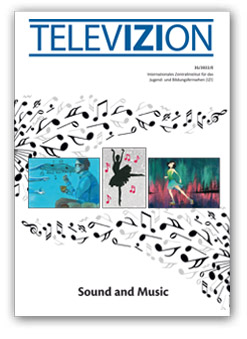|
 >> Overview publications
>> Overview publications
EDITORIAL
Music and sounds are an integral part of media reception, allowing us to immerse ourselves in the action and feel emotionally involved. We can all agree that music and sound are hugely significant for quality media. At the same time, there is hardly any existing research on the importance of music and sound in the context of children’s media (vom Orde). From our research experience in recent years, we now know why. Never before had we conducted so many audience studies in which the results were quite simply not valid, because we had not measured what we actually set out to measure. In theoretical terms, this is obvious: our brains process music and sound faster than images. Music and sound communicate with the unconscious or preconscious and “prime” the perception of the image. For children, especially younger ones, this means that it is often extremely difficult to talk about their perception and interpretation of music and sound on a meta level – partly because they perceive music more holistically than adults. Media producers therefore have an even greater responsibility here to make careful use of sound and music. A study on the use of music among the 96 finalists of the PRIX JEUNESSE INTERNATIONAL 2020 (Vestad) shows how quality television puts this into practice, and where there is still a need for action.
Studies in which different music and sound design were used with the same images have shown that the strategic use of sound combined with moments of silence is not only linked to a higher level of emotional involvement in the action, but also allows viewers to focus on the essentials (Götz & Holler). Here media are an important factor in socialization, including musical taste. Music research shows that younger children in particular are “open-eared” and can appreciate various styles of music (vom Orde).
With social networks such as TikTok, which provide music for users to add to their own videos, powerful commercial media enter the scene, bringing their own patterns of self-presentation and media use (Stüwe, Wegner & Prommer; Götz, Dömling & Brand). The increasing utilization of voice controlled devices such as Siri or Alexa brings new functions, creating additional challenges for the discussion (Kleeman). This issue of TelevIZIon summarizes the implications for quality media, and the related problems and opportunities.
Maya Götz
Head of the International Central Institute for Youth and Educational Television
RESEARCH
Ingeborg Lunde Vestad
Telling a story – music in children's television
After introducing current results from music sociology and television studies, the author analyses the use of music and instruments on the basis of 96 finalists from PRIX JEUNESSE INTERNATIONAL 2020 and discusses the quality of music in children's television.
Maya Götz/Andrea Holler
"When he sank, it went blub blub"– Sound and reception
An IZI study has investigated how much a different use of music and sounds in the same short film causes different effects in children.
Andrea Holler/Maya Götz
Happy or sad?
Andrea Holler/Maya Götz
Can children distinguish male and female voices?
Andrea Holler/Mirjam Gogolewska
How children experience classical music
Julia Stüwe/Juliane Wegner/Elizabeth Prommer
Young women are the face of TikTok
This study examines the social media app TikTok with regard to the gender representations of its users.
Maya Götz/Sarah Dömling/Selma Brand
The fascination of TikTok
David Kleeman
Speak to me!
RESEARCH DOCUMENTATION
Heike vom Orde
Music and film
Heike vom Orde
The development of children's musical perception and preferences
On the basis of selected studies, this overview summarises how children's musical perception and preferences develop and how these preferences change with age.
|




